The team led by Professor Xin Wang at the School of Future Technology has made significant research progress in various domains, including flexible electronic devices, human-machine interface, and artificial synapses.
Innovations in functional materials, mechanics, and device design have driven the rapid development of flexible wearable devices, encompassing sensing, signal transmission, and self-powered sources. Recently, Xin Wang’s team has made a series of significant research advancements in the fields of flexible electronic devices, human-machine interface, and artificial synapses. The outcomes of these studies have been published in internationally renowned journals such as Advanced Materials, Advanced Functional Materials, Nano Energy, Small, and others.
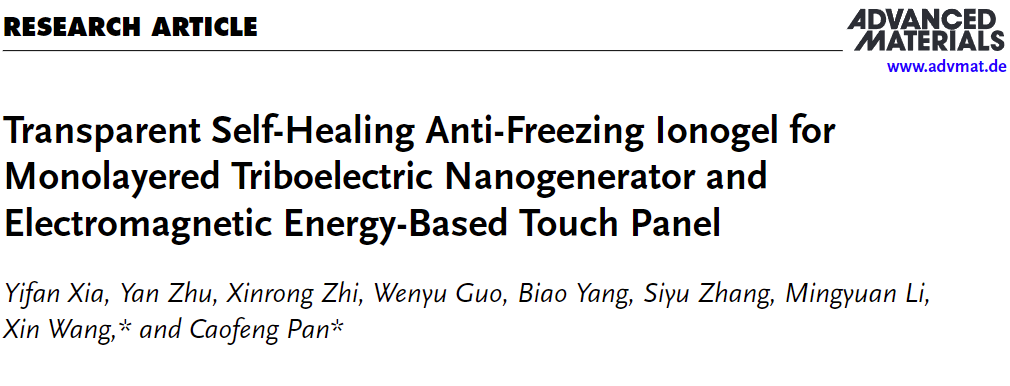
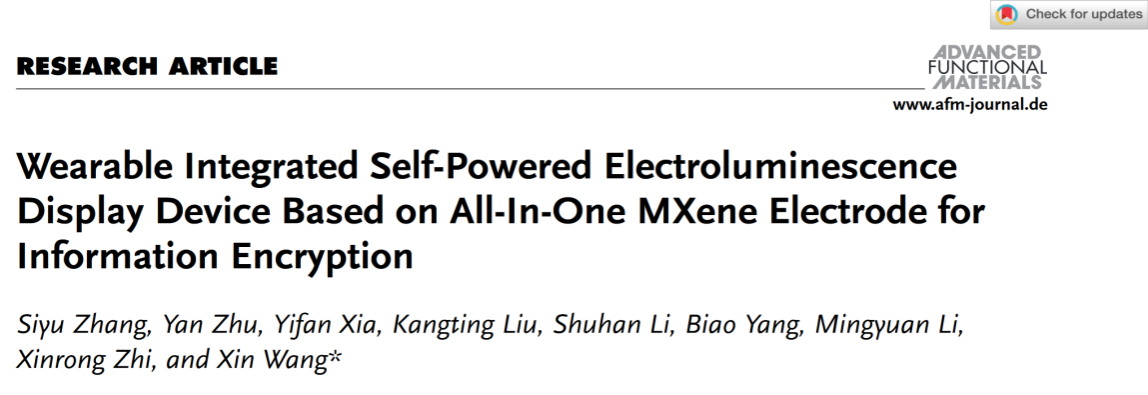
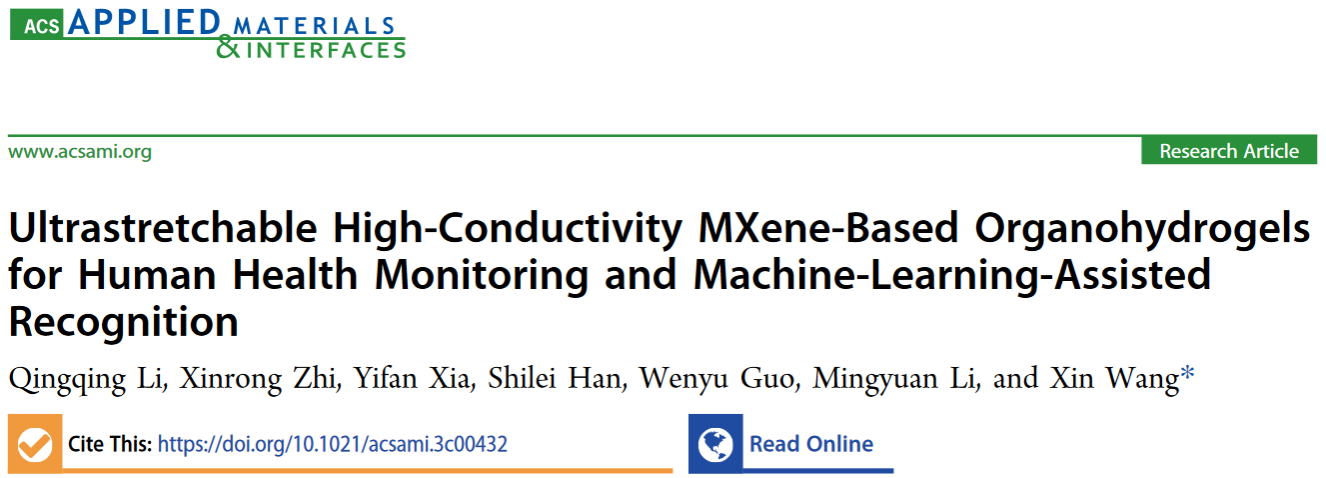


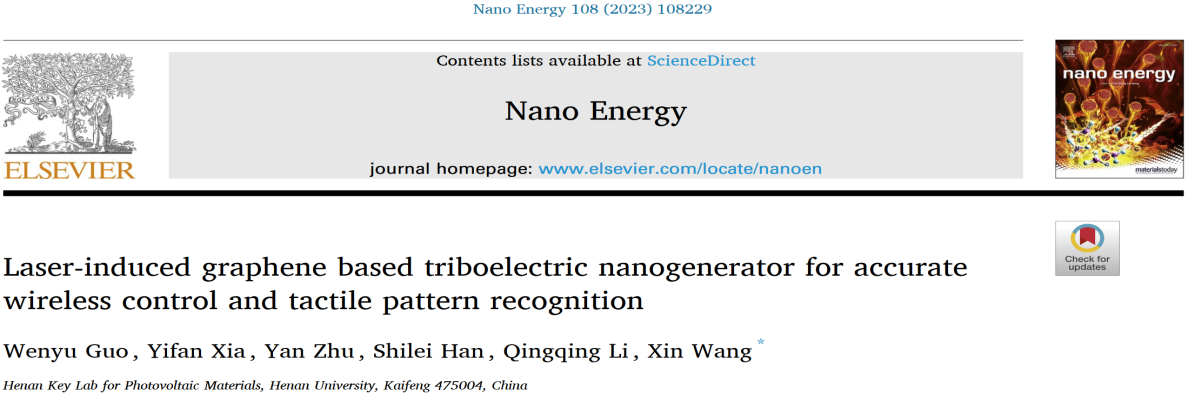
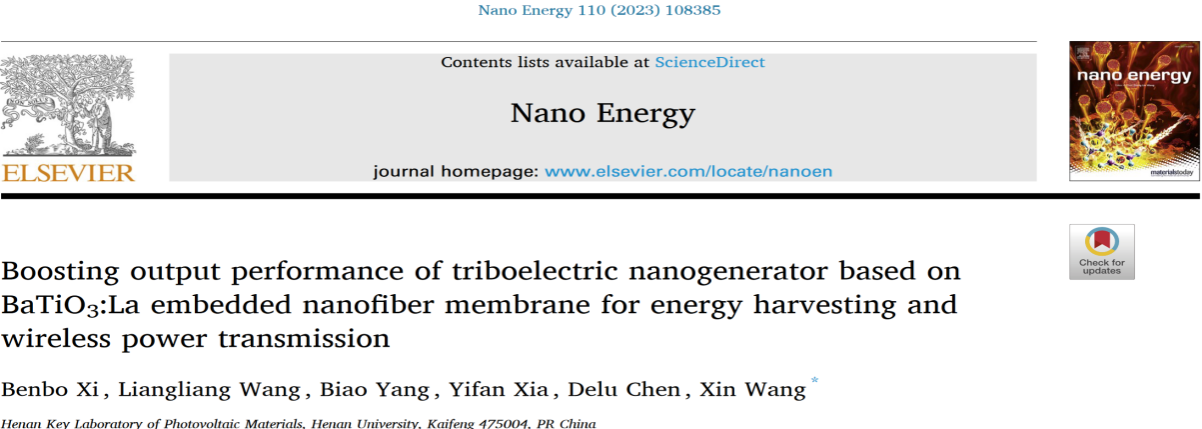

1. Transparent Self-Healing Anti-Freezing Ionogel for Monolayered Triboelectric Nanogenerator and Electromagnetic Energy-Based Touch Panel
The advent of Internet of Things and artificial intelligence era necessitates the advancement of self-powered electronics. However, prevalent multifunctional electronics still face great challenges in rigid electrodes, stacked layers, and external power sources to restrict the development in flexible electronics.
Here, Wang et al. developed a transparent, self-healing, anti-freezing (TSA) ionogel composed of fluorine-rich ionic liquid and fluorocarbon elastomer, which is engineered for monolayered triboelectric nanogenerators (M-TENG) and electromagnetic energy-based touch panels. The TSA-ionogel exhibits remarkable features including outstanding transparency (90%), anti-freezing robustness (253 K), impressive stretchability (600%), and repetitive self-healing capacity. Furthermore, harnessing Faraday’s induction law and exploiting human body’s intrinsic antenna properties, the TSA-ionogel seamlessly transforms into an autonomous multifunctional epidermal touch panel.
The TSA-ionogel’s innovation holds the potential to reshape the trajectory of next-generation electronics and profoundly revolutionize the paradigm of human–machine interaction.

https://doi.org/10.1002/adma.202308424
2. Wearable Integrated Self-Powered Electroluminescence Display Device Based on All-In-One MXene Electrode for Information Encryption
Anti-counterfeiting and visual optical information encryption/decryption technology have attracted widespread attention in the field of information security. Luminescent encryption technologies still face a huge challenge in external high voltage power supply, complex architecture, and expensive decryption equipment, which hinder their broad applications.
Wang Xin group developed a wearable integrated self-powered electroluminescent (EL) display device (W-ELD) that consists of MXene/Silicone-based triboelectric nanogenerator (MS-TENG) and EL device for patterned display and information encryption. When dripping conductive electrolyte solution, the W-ELD based on patterned MXene electrode can precisely reveal the encryption information through self-powered EL emission for real-time visualized information interaction.
Consequently, the all-in-one MXene electrode-based W-ELD that integrates both MS-TENG and EL device demonstrates exceptional patterned EL-based information encryption features, which offers a potential prospect in wearable self-powered optoelectronic devices, flexible displays, and encryption technology.
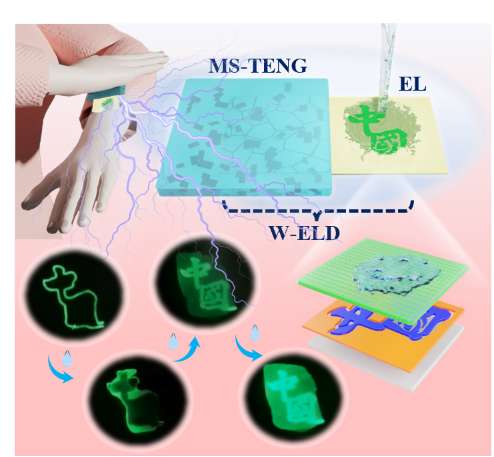
https://doi.org/10.1002/adfm.202307609
3. Ultrastretchable High-Conductivity MXene-Based Organohydrogels for Human Health Monitoring and Machine-Learning-Assisted Recognition
Conductive hydrogels as promising candidates of wearable electronics have attracted considerable interest in health monitoring, multifunctional electronic skins, and human−machine interfaces. However, to simultaneously achieve excellent electrical properties, superior stretchability, and a low detection threshold of conductive hydrogels remains an extreme challenge. Herein, an ultrastretchable high-conductivity MXene-based organohydrogel (M-OH) is developed for human health monitoring and machine learning-assisted object recognition, which is fabricated based on a Ti3C2Tx MXene/lithium salt(LS)/poly(acrylamide) (PAM)/ poly(vinyl alcohol) (PVA) hydrogel through a facile immersion strategy in a glycerol/water binary solvent. This work demonstrates excellent comprehensive performances of the ultrastretchable high-conductive M-OH in health monitoring and object recognition, which would further explore extensive potential application prospects in personal healthcare, human−machine interfaces, and artificial intelligence.
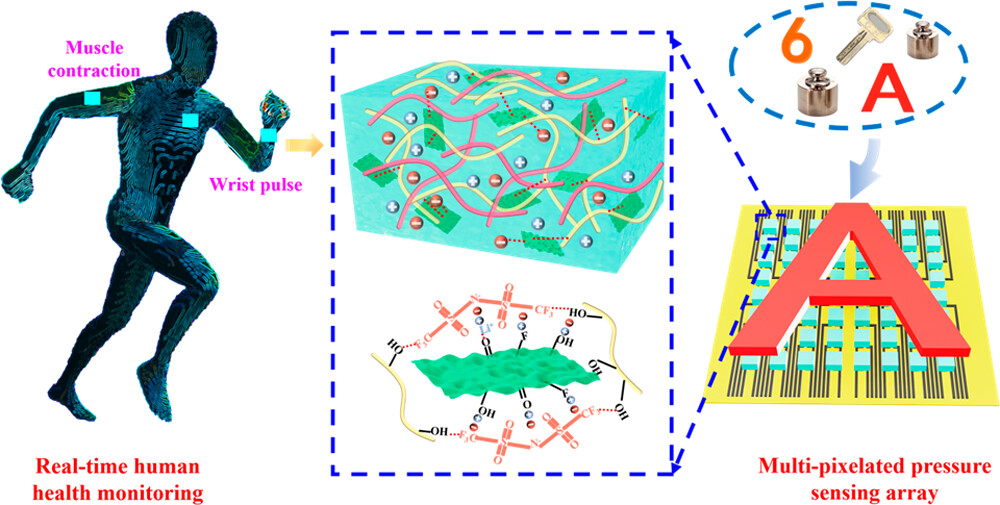
https://pubs.acs.org/doi/10.1021/acsami.3c00432
4. A Digital−Analog Bimodal Memristor Based on CsPbBr3 for Tactile Sensory Neuromorphic Computing
Memristor with digital and analog bipolar bimodal resistive switching offers a promising opportunity for the information-processing component. Here, a proposed CsPbBr3-based memristor demonstrates a high ON/OFF ratio (>103), long retention (>104 s), stable endurance (100 cycles), and multilevel resistance memory, which acts as an artificial synapse to realize fundamental biological synaptic functions and neuromorphic computing based on controllable resistance modulation. More importantly, this artificial sensory neural network system combined the artificial synapse with 5×5 tactile sensing array based on piezoresistive sensors can recognize the handwritten patterns of different letters with high accuracy of 94.44% under assistance of supervised learning. Consequently, the digital−analog bimodal memristor would demonstrate potential application in human–machine interaction, prosthetics, and artificial intelligence.
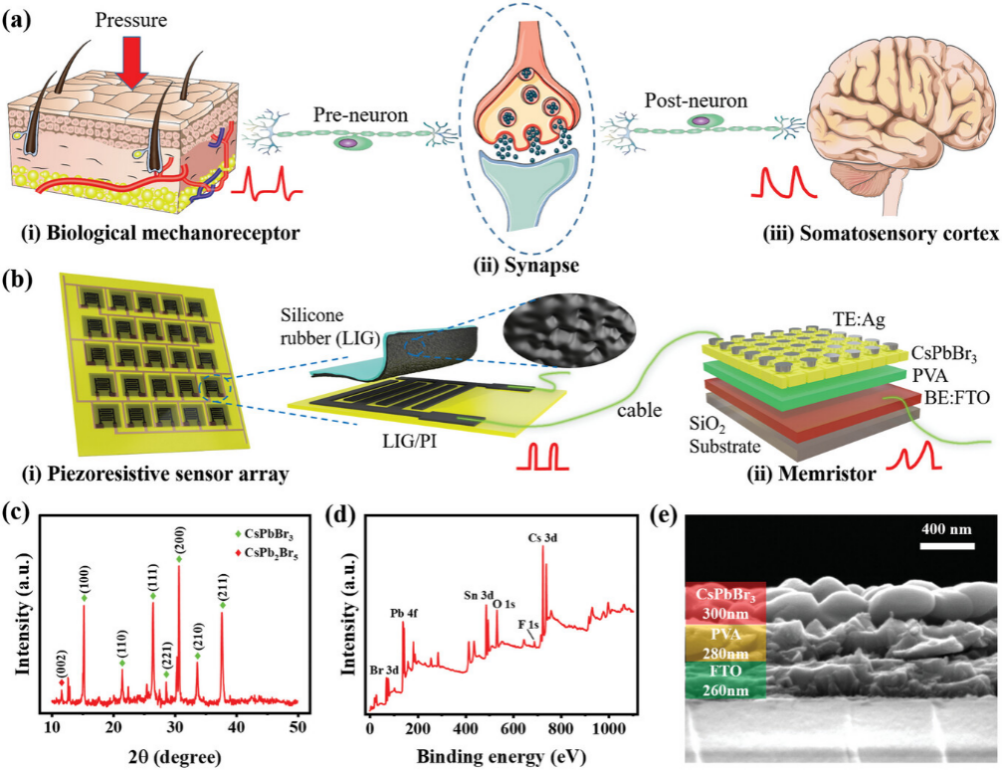
https://doi.org/10.1002/smll.202301196
5. All Resistive Pressure–Temperature Bimodal Sensing E-Skin for Object Classification
Electronic skin (E-skin) with multimodal sensing ability demonstrates huge prospects in object classification by intelligent robots. However, realizing the object classification capability of E-skin faces severe challenges in multiple types of output signals. Herein, a hierarchical pressure–temperature bimodal sensing E-skin based on all resistive output signals is developed for accurate object classification, which consists of laser-induced graphene/silicone rubber (LIG/SR) pressure sensing layer and NiO temperature sensing layer. Based on only electrical resistance as the output signal, the bimodal sensing E-skin with negligible crosstalk can simultaneously achieve pressure and temperature perception. Furthermore, a smart glove based on this E-skin enables classifying various objects with different shapes, sizes, and surface temperatures, which achieves over 92% accuracy under assistance of deep learning. Consequently, the hierarchical pressure–temperature bimodal sensing E-skin demonstrates potential application in human-machine interfaces, intelligent robots, and smart prosthetics.
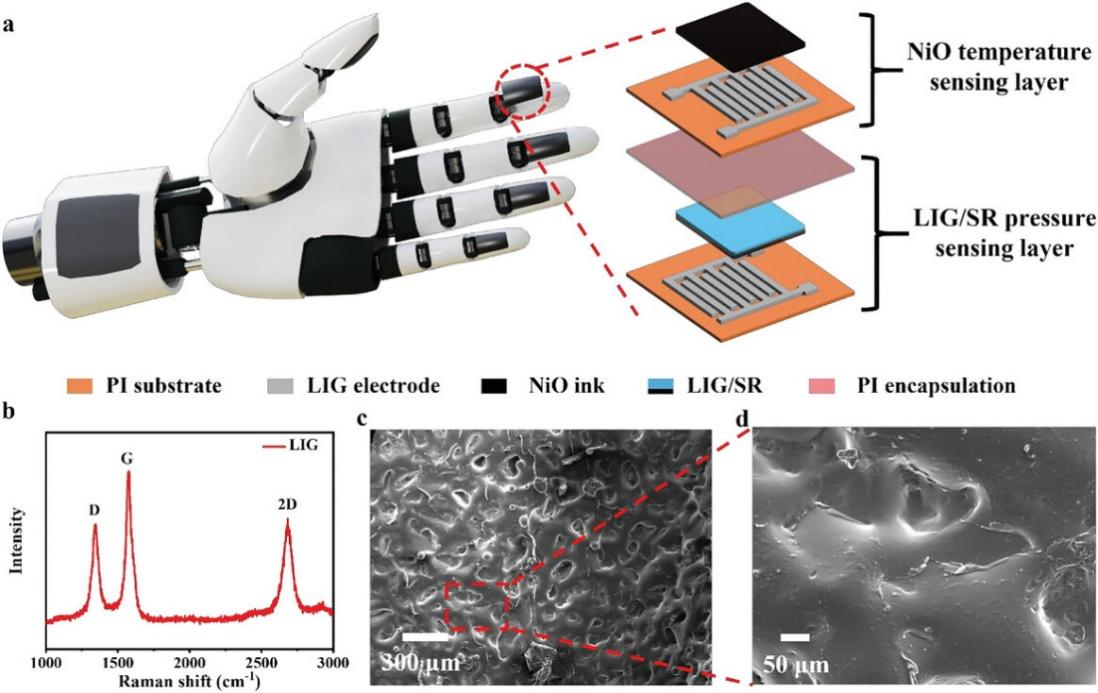
https://doi.org/10.1002/smll.202301593
6. Laser-induced Graphene Based Triboelectric Nanogenerator for Accurate Wireless Control and Tactile Pattern Recognition
Accurate control interfaces and high-sensitive tactile sensing are essential for normal and efficient operation of intelligent robots. Despite most research focus on human-machine interface (HMI), little attention is paid to autonomous control interface of the robots. Herein, one device integrated by two different working-mode laser-induced graphene (LIG)-based triboelectric nanogenerators (TENGs) is developed to achieve simultaneously its accurate wireless control and tactile pattern recognition capability. The multifunctional device integrated by two different LIG-based TENGs has achieved simultaneously accurate wireless control and sensitive tactile pattern recognition, which would demonstrate a promising application in metaverse, unmanned vehicles, and intelligent robots.
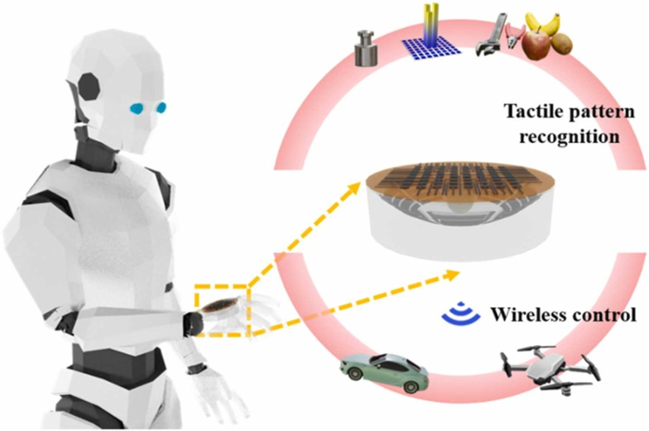
https://doi.org/10.1016/j.nanoen.2023.108229
7. Boosting Output Performance of Triboelectric Nanogenerator Based on BaTiO3:La Embedded Nanofiber Membrane for Energy Harvesting and Wireless Power Transmission
To boost output charge density for achieving high-performance triboelectric nanogenerator (TENG), increasing dielectric constant of triboelectric materials is considered as an important strategy. Herein, a high-performance TENG is fabricated based on BaTiO3:La-embedded poly (vinylidene fluoride-trifluoro-ethylene) (PVDF-TrFE) nanofiber membrane (NM) (BLPT-NM) for energy harvesting and wireless power transmission. The fabricated single electrode-mode TENG based on BLPT-NM (3 × 3 cm2) demonstrates excellent output performance with power density of 2.52 W m–2 (ƒ=1.5 Hz) and triboelectric charge density of 87.3 μC m2, which are significantly increased by more than 11- and 3-fold, respectively, in comparison with those of the TENG based on pristine PVDF-TrFE-NM. This work demonstrates an effective strategy for boosting the output performance of TENG and paves a new route to further promote the development of wireless power transmission technologies.

https://doi.org/10.1016/j.nanoen.2023.108385
8. A Portable Integrated Electrochemical Sensing System for On-Site Nitrite Detection in Food
Ensuring an appropriate nitrite level in food is essential to keep the body healthy. However, it still remains a huge challenge to offer a portable and low-cost on-site food nitrite analysis without any expensive equipment. Herein, a portable integrated electrochemical sensing system (IESS) is developed to achieve rapid on-site nitrite detection in food, which is composed of a low-cost disposable microfluidic electrochemical patch for few-shot nitrite detection, and a reusable smartphone-assisted electronic device based on self-designed circuit board for signal processing and wireless transmission. This proposed portable IESS demonstrates rapid on-site nitrite analysis and wireless data transmission within one palm-sized electronic device, which would pave a new avenue in food safety and personal bespoke therapy.
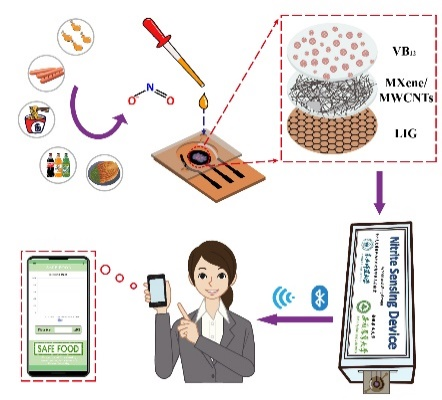
https://doi.org/10.1002/smll.202309357
The authors gratefully acknowledge financial support from the National Natural Science Foundation of China (no. 11774384) and the Natural Science Foundation of Henan (no. 232300421215).
Xin Wang, Ph.D., Professor, doctoral supervisor, is primarily engaged in research in the fields of nanoscale energy and flexible physical devices. He is currently leading three projects funded by the National Natural Science Foundation and has participated in over 10 projects, including key projects of the National Natural Science Foundation, the 863 Program, major research plans of the Chinese Academy of Sciences, and pilot projects. In recent years, he has published over 40 SCI-indexed papers, including in renowned international journals such as Adv. Funct. Mater., ACS Nano, J. Am. Chem. Soc., Nano Energy, with over 4000 citations and a single paper cited over 600 times. He holds 10 granted invention patents. He has been honored with the Excellent Award of the Chinese Academy of Sciences President, the Second Prize of the Ministry of Education Natural Science Award, the First Prize of the China Association for Instrumental Analysis Science and Technology Award, and membership in the Youth Innovation Promotion Association of the Chinese Academy of Sciences. He has previously conducted research at the School of Materials Science and Engineering, Georgia Institute of Technology, USA. Currently, he is appointed as a distinguished professor of the Yellow River Scholar Program at Henan University.



